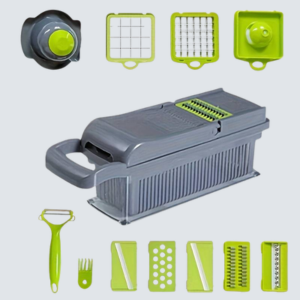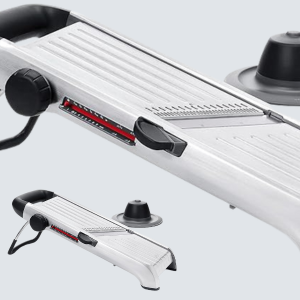Within the realm of kitchen tools tailored for efficient vegetable preparation, two prominent contenders stand out: the Vegetable Slicer/Dicer and the Mandoline Slicer. These essential kitchen devices not only simplify the process but also enable cooks to effortlessly convert raw vegetables into uniform shapes and sizes, thereby enhancing their ability to craft diverse culinary creations.. While both tools aim to simplify vegetable prep, they do so in distinct ways, catering to multiple cooking styles and preferences. This article explores the critical differences between these two kitchen aids, shedding light on their functions, versatility, safety features, and ease of use. I will help you make an informed choice on whether to select a vegetable slicer or mandoline.
Versatile Kitchen Warriors:
Comparing Vegetable Slicer or Mandoline Slicers
A Vegetable Slicer or mandoline slicer are both kitchen tools designed to help with slicing and dicing vegetables, but they have some key differences:
| Feature | Vegetable Slicer Dicer | Mandoline Slicer |
|---|---|---|
| Function: | This tool is primarily designed for dicing vegetables into uniform cubes or slices. It often comes with different attachments or blades. This allows you to create various shapes and sizes of diced vegetables. | A mandoline slicer is primarily used for slicing vegetables thinly and evenly. It doesn’t typically have attachments for dicing, but it can be adjusted to achieve different thicknesses of slices. |
| Versatility: | This tool is more versatile when creating different shapes, such as cubes, strips, or julienne cuts. Some models may also include features for spiralizing or making crinkle-cut slices. | Mandoline slicers are best suited for uniform slicing, which is excellent for making potato chips, julienne strips, or consistent salad toppings. They are not designed for dicing. |
| Safety: | Many vegetable slicer/dicer models have safety features like hand guards or pushers to protect your fingers while dicing. However, care should still be taken when using and switching out the sharp blades. Many come with base stability to prevent sliding | Mandoline slicers can be more challenging to use safely because they have a flat, sharp blade that you slide the vegetables over. Many come with a hand guard or food holder to protect their hands from the blade. Still, users should exercise caution to avoid accidental cuts |
| Ease Of Cleaning: | Cleaning a vegetable slicer/dicer can be straightforward, as many parts are detachable and dishwasher-safe. Vegetable slicer or mandoline, cleaning is easy. Also, most components are dish-washer safe. | Mandoline slicers can be a bit more challenging to clean due to the fixed blade and the need to disassemble and hand wash certain parts. Some models are dishwasher-safe, but checking the manufacturer’s instructions is essential. |


Advantages & Considerations – Vegetable Slicer or Mandoline
Vegetable Slicer/Dicer
Advantages:
- Versatile and suitable for dicing vegetables into various shapes and sizes, such as cubes, strips, and julienne cuts.
- You can save time in meal prep by quickly creating uniform pieces.
- Some models come with additional attachments for spiralizing and other tasks. For example my slicer has an egg seperator.
- It often includes safety features like hand guards.
Considerations:
- It may achieve a different level of precision than a mandoline slicer when it comes to thin slicing.
- It can have more parts to clean and maintain.
Mandoline Slicer
Advantages:
- Excellent for achieving thin, uniform slices of vegetables, fruits, and other ingredients.
- Ideal uses include chips, gratins, scalloped potatoes, and garnishes like julienne strips.
- Offers precision and consistency in slicing thickness.
- Some models have adjustable thickness settings.
- More versatile blade adjustments
Considerations:
- The mandoline may have a steeper learning curve, requiring careful handling due to the exposed, sharp blade.
- Typically, it is not designed for dicing or creating various shapes.
My Take on Vegetable Slicer or Mandoline
Conclusion
The primary distinctions between a Vegetable Slicer/Dicer and a mandoline slicer lie in their functions and versatility. Vegetable slicers/dicers excel in dicing and crafting various shapes, making them an ideal choice for these tasks In contrast, mandoline slicers excel at slicing vegetables thinly and uniformly. Choicing between the two will depend on your specific kitchen needs and the types of food preparations you frequently undertake.
Ultimately, there is no universally “better” option between the two. It depends on your specific cooking style and needs. A mandoline slicer might be a better choice if you frequently require thin, uniform slices for certain dishes. On the other hand, if you often need to dice or create various shapes, a vegetable slicer/dicer could be more versatile.
Vegetable Slicer or Mandoline? Some cooks even choose to have both tools in their kitchen to cover a broader range of tasks. For example, I use both. (I am the further thing from a chef)The key is to consider your cooking habits and which tool aligns best with the types of dishes you enjoy preparing. Also, keep in mind cleaning and storage.
I personally have both and find that they both work well. However, for my needs the Vegetable Slicer/Dicer does everything a mandoline can do and more. So, in my kitchen I usually go to the Vegetable Slicer/Dicer.
You can see specific reviews models of these slicer at Peter In A Pickle Reviews.

